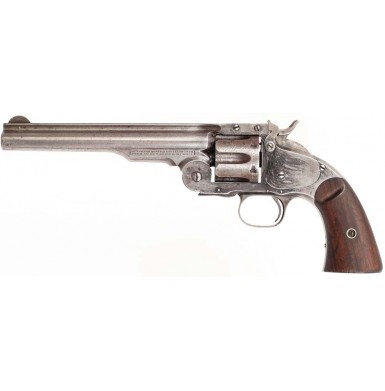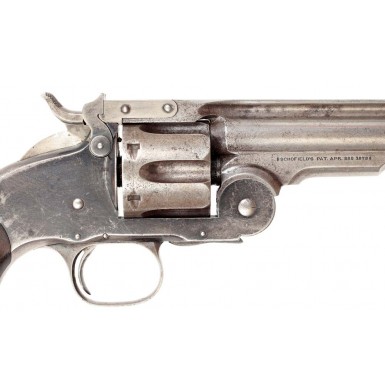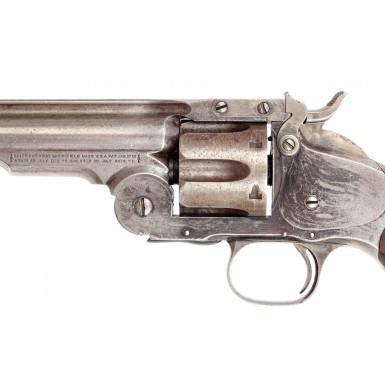1st Model Schofield Revolver - About Fine
- Product Code: FHG-1746-SOLD
- Availability: Out Of Stock
-
$1.00
In 1870, the US Army purchased its first large lot of self-contained cartridge handguns. The purchase included 1,000 .50 caliber Remington rolling block single shot pistols, 1,000 Remington New Model Army .44 caliber revolvers altered to metallic cartridge and 1,000 Smith & Wesson #3 “American” revolvers in .44 S&W. While both officers and the rank and file had been requesting cartridge revolvers from the Ordnance Department since the end of the American Civil War, two large stumbling blocks had prevented the Army from abandoning the .44 caliber percussion revolver. The first was the fact that the Rollin White patent for the bore through cylinder, which was held by Smith & Wesson, would not expire until 1869. The Ordnance Department understood that no manufacturer could produce a successful metallic cartridge revolver design until that patent expired. Secondly, the Army had a massive inventory of percussion revolvers that were now becoming obsolete and had limited value for sale on the commercial market. As a result, the army continued to use its percussion revolvers well into the mid-1870s. The three types of cartridge handguns purchased all had their various supporters and detractors. The rolling block pistol was strong, simple and durable, but only offered a single shot. The altered Remington revolvers functioned suitably, but were still considered “make do” conversions of obsolete guns. The new Smith & Wesson design was modern and offered rapid unloading and extraction due to its top break design with a built in extractor system, and offered equally quick reloading. The downside to the Smith & Wesson was that it was somewhat delicate, with numerous small parts that were prone to breakage, and it was questioned whether it could stand up to the rigors of duty on the western frontier. One army officer who was particularly impressed by the Smith & Wesson design was Major George W. Schofield of the 10th US Cavalry, one of the famous regiments of “Buffalo Soldiers”. Schofield was so impressed with the design that he arranged to act as a sales agent for Smith & Wesson. Schofield sold over 100 Smith & Wesson #3 American revolvers between the fall of 1870 and spring of 1871. Most of those guns were almost certainly sold to other cavalry officers, and as a result Schofield started to build a foundation of support for the Smith & Wesson design. Schofield did note that there could be improvements made in the #3 design, and went to work to modify the revolver to be more cavalry friendly. The most striking improvement was to redesign the latch that closed the top-break frame. The original #3 design had the latch mounted in the top strap of the revolver and required the user to hold the gun with one hand and left the latch to break the gun open with the other hand. This was awkward at best on horseback, and even more difficult if the horse was moving any faster than a walk. Schofield’s improvement relocated the latch to the frame of the revolver and designed the catch so that the thumb of the right hand could depress it while the pistol was being held in a conventional grip. The top of the barrel of the pistol could then be pushed against the trooper’s leg or saddle, opening the action and ejecting the empty cartridges. This allowed one handed opening and ejection and made the gun much easier to use on horseback. Schofield also designed improvements to the ejection system, and received patents for his innovations in June of 1871 for the latch and April of 1873 for the ejection system. With these improvements to the revolver, Schofield proceeded to arrange for US Ordnance Department trials of the new pistol. However, Schofield was a little late. In November and December of 1872 additional trials had taken place between several models of Smith & Wesson and Colt revolvers. The winning design was the Colt, a gun that would become the most famous and recognizable handgun of the old west era, the M-1873 Single Action Army, aka “Peacemaker”. The Colt design was found to be more durable, simpler, stronger, more accurate and to contain significantly fewer parts, when compared to the Smith & Wesson submissions. After the favorable testing, Colt received an order to deliver 8,000 revolvers chambered for the new .45 Colt cartridge, the cartridge found most desirable by the Ordnance Department after testing numerous cartridge designs between 1872 and 1873. Schofield should have accepted defeat at this point, but he had quite a bit of political pull within the army. His brother was General John Schofield of Civil War fame, and the General was a friend of General William Tecumseh Sherman, who served as General of the Army (five star general) from 1869-1883. General Schofield had also served briefly as the Acting Secretary of War (June 1868-March 1869), had been in command of the Military Division of the Pacific and in 1876 would be made the Superintendent of The US Military Academy at West Point. Between Major Schofield’s inroad with officers who supported the Smith & Wesson design and the political influence of his brother, he managed to get his redesigned Smith & Wesson revolver in front of the Board of Ordnance for review in June of 1874. The findings were sufficiently positive that a contract was let to Smith & Wesson for 3,000 of the new “Schofield” model revolver in September of 1874. These guns would become known to collectors as 1st Model Schofield revolvers. They were six-shot, single-action revolvers with 7” ribbed barrels, and a square butt profile and two piece walnut grips. While most were blued with color case hardened triggerguards and hammers, some were delivered with a factory nickel finish. These .45 caliber revolvers were chambered for the .45 S&W (aka .45 Schofield) cartridge. The action of the revolver could not function with the standard .45 Colt cartridge. The Colt cartridge was too long for the Smith & Wesson cylinder, and the rim of the Colt cartridge was too small to be effectively engaged by the star extractor of the Smith & Wesson design, which meant that the Colt cases would fall through the extractor and become stuck in the cylinder chambers. The .45 S&W cartridge was about .10” shorter than the .45 Colt, with a larger rim, and slightly smaller powder charge and lighter bullet. The Smith & Wesson cartridge could be used in the Colt revolvers, but the Colt cartridge could not be used in the Smith & Wesson guns. Initial reports from the field were positive enough that a second contract was let to Smith & Wesson for 3,000 more revolvers in March of 1875. These would become known to collectors as the 2nd Model Schofield. In all, a total of 5,285 2nd Model Schofields were delivered to the US Army between 1876 and 1877, with a total production of 5,934. In most respects the guns were identical to the preceding “1st Model”, with the most noticeable improvement being the dishing out of the barrel catch to make it easier to put your thumb into it and open the action. This also changed the profile of the catch itself and the rear sight that was built into the catch. The other major change cannot be seen, but the frames of the 2nd Model Schofield revolvers were made of steel instead of iron. Major Schofield received a $.50 per unit royalty payment for design improvements for every 2nd Model that was sold, but did not receive any royalty payments for the 1st Model revolvers. The Schofield revolvers were issued throughout the US cavalry in an attempt to get good side-by-side comparisons of their effectiveness and durability as compared to the Colt M-1873. The guns saw significant service with the 4th US Cavalry, as well as with the 9th & 10th US Cavalry (the Buffalo Soldiers). However, it was not long before the original complaints about the Smith & Wesson #3 in terms of fragility and mechanical issued began to rear their ugly heads again. However, the ammunition for the guns caused an even bigger problem. The intentional issue of the Colt and Smith & Wesson revolvers to the same regiments resulted in ammunition snafus. In an attempt to circumvent this issue, Frankford Arsenal developed a universal cartridge for use in both revolvers. It was shorter and lower powered than the .45 Colt and had a slightly larger rim to help with extraction from the Smith & Wesson. However, it was not uncommon for .45 Colt ammunition to be issued to troops with Schofield revolvers, who could not use it in their guns. Likewise, the .45 S&W ammo had such a large rim that it often prevented all of the chambers from being loaded in a Colt revolver, or could even cause the Colt cylinder to bind up. Despite the significant advantage in unloading and loading speed that the Schofield offered, the numerous small issues with the mechanism and the ammunition difficulties resulted in the gradual removal of the Smith & Wesson revolvers from US military service. This is somewhat ironic, as during the decade from 1873 to 1882, Smith & Wesson would produce about twice as many of their large frame single action revolvers (mostly the various #3 variants) than Colt would produce Single Action Army revolvers. Smith & Wesson found their success with the civilian market and with foreign military contracts, while Colt continued to find the US government their most lucrative customer. During the 1880s, the US military began divesting themselves of both 1st & 2nd Model Schofield revolvers. The guns were primarily sold to Schuyler, Hartley & Graham and Francis Bannerman & Company, both of New York. Many of these guns were subsequently altered by having their 7” barrels cut down to 5”, and the guns were nickel-plated for civilian sale. The single largest customer for these altered Schofield revolvers was the Wells Fargo Express Company, who marked the guns W.F. & Co. Ex. when they purchased them. However, some Schofield revolvers remained in service right up to the era of the Spanish American War, and some are noted by serial number in the Springfield Research Service series of serial number books as being in used during the mid to late 1890s, mostly with State and National Guard units. As the large majority of military contract Schofields were sold as surplus and altered during the 1880s and 1890s, it is difficult to find them in fine original condition and in their original configuration. Much like the 7 ““ Single Action Army “cavalry” revolvers that were mostly altered to mixed number, 5 ““ “artillery” configuration, original cavalry Schofields are scarce and extremely desirable.
Offered here is a NEAR FINE condition example of a Smith & Wesson 1st Model Schofield cavalry revolver. The gun is 100% complete and correct in every way and is a very crisp, unaltered example of a scarce US military revolver from the height of the Indian War era. The revolver is serial number 1907, and that number is clearly stamped in the butt of the revolver, along with the ownership mark US. The serial number is also clearly stamped on the rear face of the cylinder and inside the right grip panel. The inspector initials L and P are crisply stamped in the bottom of the barrel web, with the initials P and L on the rear face of the cylinder and the initial L on the inside top of the bottom of the frame. The “L” is the mark of Ordnance Department inspector D.A. Lyle, The left side of the ejector housing is clearly stamped in two lines, with a Maltese Cross at each end of the legend:
The right side of the ejector housing is marked in a single line:
SCHOFIELD’s PAT. APR. 22D 1873
This line is also flanked by a pair of Maltese Crosses. The left grip also bears a very good cartouche. The left grip has a very visible script JFEC., for US Ordnance Department sub-inspector Lt. J.F.E. Chamberlain. This gun would have been produced about 2/3 of the way through the production for the 1st Schofield contract. The pistol is really in about NEAR FINE condition. The frame retains about 40%+ of its original blue overall, showing flaking, toning and fading. The right side of the frame retains the largest amount of original finish, with the left side retaining about half as much as the right. The finish is most prevalent in the areas behind the recoil shield, back towards the grips. There is also strong blue remaining on the rear of the recoil shield and on the bottom of the frame. The barrel retains strong traces of blue in the groove of the rib along the top of the barrel, and in other protected areas. Overall, the gun retains about 20%+ original blue, averaged across the entire gun. The areas of finish loss have a pewter undertone with a thin plum-brown patina that is developing on the surfaces. The frame is very smooth with only some lightly scattered traces of pinpricking present. The barrel shows some lightly scattered areas of minor surface oxidation, light pinpricking and minor light pitting near the muzzle. The cylinder shows a similar surface patina as the barrel, with a slightly thicker layer of brown oxidation and the same scattered pinpricking and very light pitting present as found on the barrel. The bore of the revolver is in about VERY GOOD+ condition and remains mostly bright with crisp rifling that shows some light to moderate pitting scattered along its length. The bore shows some scattered dirt and debris and would probably improve with a good scrubbing. The hammer retains about 30%+ mottled case coloring, which has faded and dulled to a medium pewter gray base color with darker case hardened mottling still visible. The hammer spur retains fine, sharp checkering. The triggerguard retains some minor traces of its mottled case coloring, which is confined to the protected areas in the web at the rear of the triggerguard. The balance of the triggerguard is a smoky silvery-gray, with some very minute traces of mottling present. The trigger retains about 20%+ original niter blue, with the expected fading and wear on the face and silvering on the edges and contact points. The screws all retain some minor traces of their pale niter blued finish. All of the screw heads are in very good condition, with a couple showing light slot wear, and the balance appearing quite crisp and relatively untouched. The revolver is mechanically EXCELLENT and functions perfectly. The pistol indexes, times and locks up perfectly, and the extraction system functions smoothly and correctly. The revolver locks up tightly and the frame to barrel fit is excellent with no wobble or looseness. The two-piece walnut grips rate VERY FINE and are in really great condition for a set of US martial grips from the Indian War era. They both are solid and complete with no breaks, cracks, chips or repairs. As noted the right grip panel is correctly stamp-numbered to the revolver on its interior and the left grip retains s very good cartouche. The grips do show some light bumps and dings from handling, use and storage, but are in truly wonderful condition.
Overall this is a really crisp, about fine condition example of a very scarce US martial handgun from the Indian War era. This wonderful Smith & Wesson 1st Model Schofield is absolutely 100% complete and correct in every way. The revolver was delivered in 1875, a year before Brevet General George Armstrong Custer led his 7th Cavalry to their death along the banks of the Little Big Horn River. 1st Model Schofields are rather scarce, with only 3,000 delivered on contract to the military during 1875, slightly more than half as many of the 2nd Model Schofields delivered over the next two years. By contrast, some 37,000 US M-1873 Single Action Army revolvers were accepted for US military service between 1873 and 1892; about 12 times as many! With many of the Schofields being sold as surplus, and subsequently having their barrels shortened and getting new nickel finishes, it is rather difficult to find an all original, un-altered Schofield for sale. This revolver may have escaped the gunsmiths at Bannerman’s and Schuyler, Hartley & Graham by being issued to a State Guard regiment during the 1880s. With most of the 1st Model Schofields seeing hard service on the frontier with the 4th, 9th & 10th US Cavalry, these guns are hard to find in any condition, let along in crisp condition with some original finish on them. This is simply a very nice example of a US cavalry revolver, accepted into service during the height of the Indian War period, and significantly rarer than a US military Single Action Army revolver. 1st Model Schofield revolvers rarely appear in such nice condition and a state of preservation that includes any original finish. This would be a very nice example to add to your US martial handgun collection. A Single Action Army in this condition and from this era would probably sell for in excess of $12,500, especially if it was an Ainsworth inspected gun. This is a scarcer gun overall, and about S the price of a comparable Nettleton inspected Colt or a “ of the price of Ainsworth gun. Don’t miss your chance to add a truly nice piece of US military an Indian War history to your collection.







